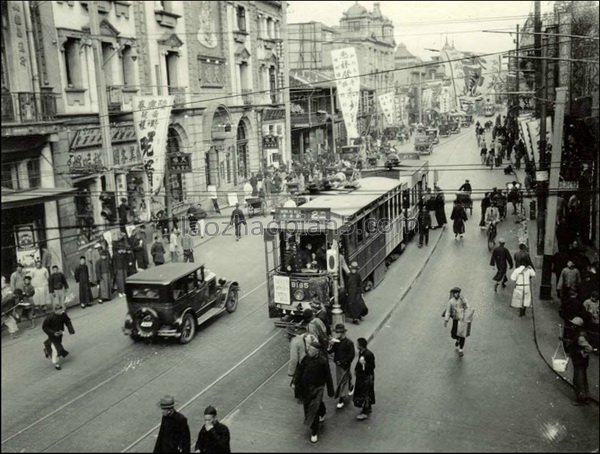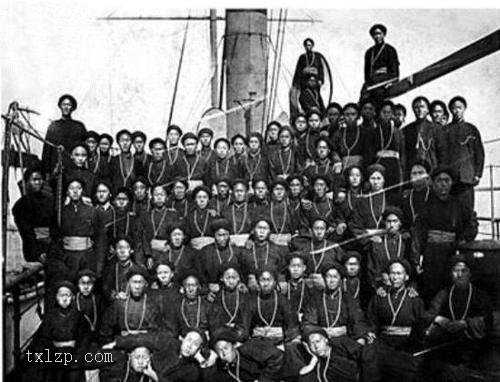Period:Unknown Production date:6thC-7thC
Materials:stucco, 灰泥 (Chinese),
Technique:mould-made, painted, 模製 (Chinese),
Subjects:military 軍事的 (Chinese)
Dimensions:Height: 42.80 centimetres
Description:
Stucco figure of a standing warrior wearing a scale armour and a helmet. The figure was made using a mould and then painted in green, red and yellow. When found, the figure was broken into three pieces that were re-assembled at a later point. For more information see curatorial comment below.
IMG
![图片[1]-figure; 畫像(Chinese) BM-MAS.1061-China Archive](https://chinaarchive.net/Unknown/43/mid_01144236_001.jpg)
![图片[2]-figure; 畫像(Chinese) BM-MAS.1061-China Archive](https://chinaarchive.net/Unknown/43/mid_01144241_001.jpg)
![图片[3]-figure; 畫像(Chinese) BM-MAS.1061-China Archive](https://chinaarchive.net/Unknown/43/mid_01144162_001.jpg)
![图片[4]-figure; 畫像(Chinese) BM-MAS.1061-China Archive](https://chinaarchive.net/Unknown/43/mid_00009201_002.jpg)
Comments:EnglishFrom Whitfield 1985:The occurrence of more or less identical figures through the use of moulds has enabled this figurine of a warrior in armour to be shown complete with spear and shield, although the three components were found separately in the same shrine at Ming-oi, in the passage (xii) behind the cella (xi). The decoration of the whole shrine consisted mainly of relief friezes along the walls. Stein recovered hundreds of fragments, but owing to damage by fire few had retained the original colouring as this example has. The friezes of relief figures had been fixed to the walls on a wooden framework, square holes for which are clearly seen in one of Stein’s photographs (Serindia, Vol. Ⅲ, Fig. 291). The holes were in rows, the lowest about sixty centimetres from the ground and the next one and a half metres higher. At one point a projecting, cornice still remained, made of stucco over a wood and reed wattle framework, with rows of holes left by the small pegs which had fastened the figures to it. They had included a striking proportion of warrior figures such as this one. Perhaps they originally represented soldiers of the army of Mara. Their appearance and accoutrements have been excellently described by Stein in his entry for one of the figures (Mi. xi 00109); Serindia, Vol. Ⅲ, p. 1209). From this we learn the full extent of the colouring. The highly arched eyebrows, drawn down and in at their inner corners to make vertical furrows in the forehead and giving a fierce expression, were originally black, as were the protruding eyeballs, and the small moustache and imperial. The lips were crimson, and the face was coloured red, with a good deal of ochre. The helmet is close-fitting, made up of leather scales and with a boss to receive a crest and a central projecting piece to protect the forehead between the eyebrows. The temples are protected by check pieces, and a gorget fits closely around the chin and protects the neck and upper chest. According to Stein, the whole helmet was painted in one colour, either red or green. Some of these features are very clearly seen in Mi. xii. 009 (Fig. 137), where the gorget was painted green. On his body, the warrior wears a long tunic of scale-armour, with a heavy rolled collar, belted with a double cord in red and divided below the waist. The scales, which might be of iron rather than lacquered leather, are arranged in double rows, red, green or gilded. He carries a spear and a circular shield evidently of leather, with five bosses. A similar warrior, but with armour definitely composed of leather scales rounded at the top as seen in some of the Stein lacquered scales (Pl. 49), was found at Ming-oi by Huang Wenbi and is illustrated by him (Huang Wenbi, 1958, Pl. 42). Many elements, from the projection on he helmet to the single long suit of the main armour, recall Sasanian or Iranian examples. The type appears to have been widespread across Central Asia: similar coats with wide lapels are worn by the aristocratic donors of some of the wall paintings in Buddhist shrines near Kizil. In the Hermitage Museum, Leningrad, are a number of important finds brought from Kucha by Oldenburg. They include both soldiers from Mara’s army, preserved with their colouring largely intact, and a large intact mould for making similar figures. These all have plain tunics rather than scale-armour, but the forms of the rolled collar with its lapels, and of the helmets and gorgets, are the same. Their bright polychrome colouring allows us to imagine the art of the shrines at Ming-oi as it originally appeared and in relation both to the wall paintings of Kizil to the west, and to the later figures found by Kozlov at Karakhoto farther east and now also in the Hermitage Museum. ChineseFrom Whitfield 1985:由於是用模子製作的像外觀幾乎相同,因此本圖展示的身著鎧甲的武士與槍和盾可以作爲完整的圖像來展示,儘管武士、盾和槍分別從明屋遺迹同一寺址的通路(xii)和小室背後(xi)等不同場所發現的。那個寺址的內部裝飾,是以壁面上加半雕的帶狀裝飾爲主。斯坦因發現的大量這種斷片,由於火災的破壞,如本圖的像一樣保持住原來色彩的極爲罕見。一連串的半雕像用木釘安裝在牆壁上,在斯坦因所攝的照片中,可見到残留的方洞(參照《西域》第3卷,Fig. 291)。洞是成行排列的,最下邊的離地面60釐米,上邊的約在150釐米處。用木和槁草編織的框架上,泥作突出的壁楣現只剩一處,洞中仍留著固定塑像的小木釘。一連串的半雕像中,有幾个如本圖这样的優美匀称的武士像,它們大概是魔王的士兵。有關其外觀和裝扮,斯坦因就收集品中的一件做了精闢的介紹(參照《西域》第3卷1209頁,Mi.xi.00109的解說)。細看本圖的像可以發現整個像都上了彩。如當初眉用墨描出很彎的弧形,眉間加了縱皺,産生出勇猛形象。另外,突出的眼球和小髭鬍等也用墨描,唇是紅色、臉上塗了赤和黃褐色。看似革製的兜鍪戴在頭上正合適,頂部有兜飾的座,前面可见突出保護眉間的片。而太陽穴被兩側垂下的部分護着,脖子和前胸上部恰好緊緊包在颚圍中得到保護。據斯坦因講,整个兜鍪都上過赤或綠的色彩。上述的若干特徵,在其他Mi. xii. 009武士的頭部(Fig. 137)也可清楚看到,那武士的喉部上塗了綠色。本圖的武士著大卷領長裾鱗鎧甲,腰系兩條紅色腰帶,鎧甲從腰以下分叉。鎧甲的鱗片可能不是塗漆的革,是鐵的,紅、綠、金色交替配出兩列。武士持著槍和圓形盾,盾明顯是革製的,有五個浮凸飾。黃文弼從明屋遺迹發現有同樣的武士像,刊載在他的著作(《塔里木盆地考古记》北京,1958年,圖版42)中,但鎧甲與斯坦因發現的若干塗漆鱗片(參照彩色圖版第49圖)相同,上端是圓形,明顯是革製的鱗片。從兜鍪頂部的突起到長單衣的鎧甲,其風格使人想起薩珊王朝波斯或伊朗的因素。大概此風格曾在中亞廣泛流傳,在克孜爾近郊的佛寺壁畫上也見到有穿相同寬折領大衣的貴族供養人像。另外,聖彼得堡艾爾米塔什美術館收藏的奧登堡從庫車發掘的的大量珍貴文物中,有色彩保留非常好的魔王士兵們,以及兩塊模子。不僅是鎧甲,那些簡單的長襟外衣,翻領的卷邊,以及兜鍪和護喉具的風格等都一樣。那些鮮豔多彩的顔色,不僅與西方的克孜爾壁畫有關,還出現在明屋的美術品中,在時代稍晚,科茲洛夫發現於遙遠的東方黑水城現藏於艾爾米塔什美術館的諸像,也受到波及和影響。
Materials:stucco, 灰泥 (Chinese),
Technique:mould-made, painted, 模製 (Chinese),
Subjects:military 軍事的 (Chinese)
Dimensions:Height: 42.80 centimetres
Description:
Stucco figure of a standing warrior wearing a scale armour and a helmet. The figure was made using a mould and then painted in green, red and yellow. When found, the figure was broken into three pieces that were re-assembled at a later point. For more information see curatorial comment below.
IMG
![图片[1]-figure; 畫像(Chinese) BM-MAS.1061-China Archive](https://chinaarchive.net/Unknown/43/mid_01144236_001.jpg)
![图片[2]-figure; 畫像(Chinese) BM-MAS.1061-China Archive](https://chinaarchive.net/Unknown/43/mid_01144241_001.jpg)
![图片[3]-figure; 畫像(Chinese) BM-MAS.1061-China Archive](https://chinaarchive.net/Unknown/43/mid_01144162_001.jpg)
![图片[4]-figure; 畫像(Chinese) BM-MAS.1061-China Archive](https://chinaarchive.net/Unknown/43/mid_00009201_002.jpg)
Comments:EnglishFrom Whitfield 1985:The occurrence of more or less identical figures through the use of moulds has enabled this figurine of a warrior in armour to be shown complete with spear and shield, although the three components were found separately in the same shrine at Ming-oi, in the passage (xii) behind the cella (xi). The decoration of the whole shrine consisted mainly of relief friezes along the walls. Stein recovered hundreds of fragments, but owing to damage by fire few had retained the original colouring as this example has. The friezes of relief figures had been fixed to the walls on a wooden framework, square holes for which are clearly seen in one of Stein’s photographs (Serindia, Vol. Ⅲ, Fig. 291). The holes were in rows, the lowest about sixty centimetres from the ground and the next one and a half metres higher. At one point a projecting, cornice still remained, made of stucco over a wood and reed wattle framework, with rows of holes left by the small pegs which had fastened the figures to it. They had included a striking proportion of warrior figures such as this one. Perhaps they originally represented soldiers of the army of Mara. Their appearance and accoutrements have been excellently described by Stein in his entry for one of the figures (Mi. xi 00109); Serindia, Vol. Ⅲ, p. 1209). From this we learn the full extent of the colouring. The highly arched eyebrows, drawn down and in at their inner corners to make vertical furrows in the forehead and giving a fierce expression, were originally black, as were the protruding eyeballs, and the small moustache and imperial. The lips were crimson, and the face was coloured red, with a good deal of ochre. The helmet is close-fitting, made up of leather scales and with a boss to receive a crest and a central projecting piece to protect the forehead between the eyebrows. The temples are protected by check pieces, and a gorget fits closely around the chin and protects the neck and upper chest. According to Stein, the whole helmet was painted in one colour, either red or green. Some of these features are very clearly seen in Mi. xii. 009 (Fig. 137), where the gorget was painted green. On his body, the warrior wears a long tunic of scale-armour, with a heavy rolled collar, belted with a double cord in red and divided below the waist. The scales, which might be of iron rather than lacquered leather, are arranged in double rows, red, green or gilded. He carries a spear and a circular shield evidently of leather, with five bosses. A similar warrior, but with armour definitely composed of leather scales rounded at the top as seen in some of the Stein lacquered scales (Pl. 49), was found at Ming-oi by Huang Wenbi and is illustrated by him (Huang Wenbi, 1958, Pl. 42). Many elements, from the projection on he helmet to the single long suit of the main armour, recall Sasanian or Iranian examples. The type appears to have been widespread across Central Asia: similar coats with wide lapels are worn by the aristocratic donors of some of the wall paintings in Buddhist shrines near Kizil. In the Hermitage Museum, Leningrad, are a number of important finds brought from Kucha by Oldenburg. They include both soldiers from Mara’s army, preserved with their colouring largely intact, and a large intact mould for making similar figures. These all have plain tunics rather than scale-armour, but the forms of the rolled collar with its lapels, and of the helmets and gorgets, are the same. Their bright polychrome colouring allows us to imagine the art of the shrines at Ming-oi as it originally appeared and in relation both to the wall paintings of Kizil to the west, and to the later figures found by Kozlov at Karakhoto farther east and now also in the Hermitage Museum. ChineseFrom Whitfield 1985:由於是用模子製作的像外觀幾乎相同,因此本圖展示的身著鎧甲的武士與槍和盾可以作爲完整的圖像來展示,儘管武士、盾和槍分別從明屋遺迹同一寺址的通路(xii)和小室背後(xi)等不同場所發現的。那個寺址的內部裝飾,是以壁面上加半雕的帶狀裝飾爲主。斯坦因發現的大量這種斷片,由於火災的破壞,如本圖的像一樣保持住原來色彩的極爲罕見。一連串的半雕像用木釘安裝在牆壁上,在斯坦因所攝的照片中,可見到残留的方洞(參照《西域》第3卷,Fig. 291)。洞是成行排列的,最下邊的離地面60釐米,上邊的約在150釐米處。用木和槁草編織的框架上,泥作突出的壁楣現只剩一處,洞中仍留著固定塑像的小木釘。一連串的半雕像中,有幾个如本圖这样的優美匀称的武士像,它們大概是魔王的士兵。有關其外觀和裝扮,斯坦因就收集品中的一件做了精闢的介紹(參照《西域》第3卷1209頁,Mi.xi.00109的解說)。細看本圖的像可以發現整個像都上了彩。如當初眉用墨描出很彎的弧形,眉間加了縱皺,産生出勇猛形象。另外,突出的眼球和小髭鬍等也用墨描,唇是紅色、臉上塗了赤和黃褐色。看似革製的兜鍪戴在頭上正合適,頂部有兜飾的座,前面可见突出保護眉間的片。而太陽穴被兩側垂下的部分護着,脖子和前胸上部恰好緊緊包在颚圍中得到保護。據斯坦因講,整个兜鍪都上過赤或綠的色彩。上述的若干特徵,在其他Mi. xii. 009武士的頭部(Fig. 137)也可清楚看到,那武士的喉部上塗了綠色。本圖的武士著大卷領長裾鱗鎧甲,腰系兩條紅色腰帶,鎧甲從腰以下分叉。鎧甲的鱗片可能不是塗漆的革,是鐵的,紅、綠、金色交替配出兩列。武士持著槍和圓形盾,盾明顯是革製的,有五個浮凸飾。黃文弼從明屋遺迹發現有同樣的武士像,刊載在他的著作(《塔里木盆地考古记》北京,1958年,圖版42)中,但鎧甲與斯坦因發現的若干塗漆鱗片(參照彩色圖版第49圖)相同,上端是圓形,明顯是革製的鱗片。從兜鍪頂部的突起到長單衣的鎧甲,其風格使人想起薩珊王朝波斯或伊朗的因素。大概此風格曾在中亞廣泛流傳,在克孜爾近郊的佛寺壁畫上也見到有穿相同寬折領大衣的貴族供養人像。另外,聖彼得堡艾爾米塔什美術館收藏的奧登堡從庫車發掘的的大量珍貴文物中,有色彩保留非常好的魔王士兵們,以及兩塊模子。不僅是鎧甲,那些簡單的長襟外衣,翻領的卷邊,以及兜鍪和護喉具的風格等都一樣。那些鮮豔多彩的顔色,不僅與西方的克孜爾壁畫有關,還出現在明屋的美術品中,在時代稍晚,科茲洛夫發現於遙遠的東方黑水城現藏於艾爾米塔什美術館的諸像,也受到波及和影響。
© Copyright
The copyright of the article belongs to the author, please keep the original link for reprinting.
THE END



![[Qing Dynasty] British female painter—Elizabeth Keith, using woodblock prints to record China from the late Qing Dynasty to the early Republic of China—1915-China Archive](https://chinaarchive.net/wp-content/uploads/2022/11/image-191x300.png)

